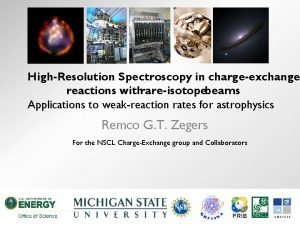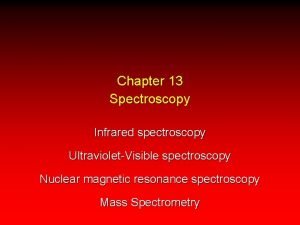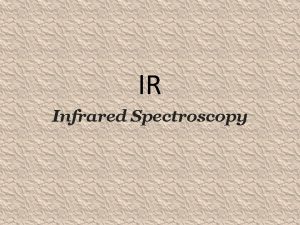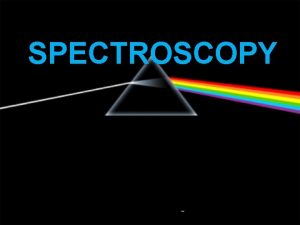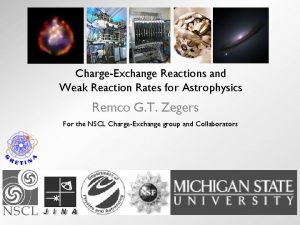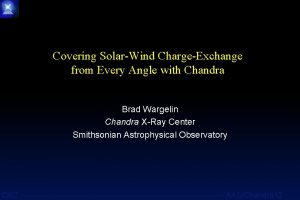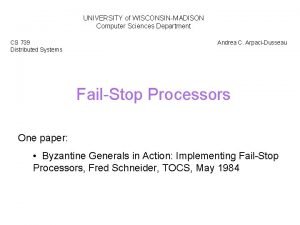ChargeExchange Spectroscopy at the University of WisconsinMadison Mark





















- Slides: 21

Charge-Exchange Spectroscopy at the University of Wisconsin-Madison Mark Nornberg Santhosh Kumar, Daniel Den Hartog Alexis Briesemeister 2012 ADAS Workshop CEA Cadarache, France 24 Sept. 2012

Overview of CX measurements on 2 devices at Madison Helically Symmetric Experiment (HSX) Stellarator Madison Symmetric Torus (MST) Reversed Field Pinch • Effect of quasi-symmetry on neoclassical transport • RFP as potential reactor design • General toroidal confinement physics • Astrophysical processes

HSX is a Stellarator Optimized For Quasi-Helical Symmetry <R> 1. 2 m <a> 0. 12 m • ne 6 1012 cm-3 • Te ~ 0. 5 - 2. 5 ke. V Ti ~ 30 -60 e. V • 30 ke. V H beam stimulates C+5 emission B 0 ECRH 28 GHz 1. 05 1. 12 1. 0 T 100 k. Wx 2

Goal is to measure radial electric field and its impact on transport • Neoclassical transport suppressed by sheared E×B flow • Measuring flows and ion pressure gradient allows Er to be determined from force balance: • These measurements test models used to predict Er and plasma flows

ADAS modeling is essential to interpret C+6 emission in HSX Velocity Measured By Each View “Toroidal” Views “Poloidal” Views Velocity Along and Across the Symmetry Direction Electron and Ion Temperatures Te T+6~50 e. V • Ion flow determined from Doppler shift of 529 nm n=8 -7 transition (2 views for magnitude and direction) • Large intrinsic flow along helical direction of symmetry due to reduced parallel viscosity

The Madison Symmetric Torus Experiment provides a platform for addressing ion confinement, heating, and acceleration • • • Reversed Field Pinch R = 1. 5 m a = 0. 52 m Pulse length: 60 -120 msec (20 msec flattop) Ip = 200 – 650 k. A ne = 0. 5 – 1. 5 × 1019 m-3 (puffing) 6 × 1019 m-3 (with pellet injection) • Ohmically heated • Access to a range of plasmas – Te ~ Ip in standard RFPs – Te up to 2 ke. V in enhanced confinement – Ti up to 1 ke. V

Charge-exchange recombination spectroscopy (CHERS) measures local carbon impurity Tperp, Tpar, and n. C.

Ion heating from magnetic reconnection

Standard RFPs in MST are punctuated by impulsive quasiperiodic bursts of reconnection events (sawteeth) • Plasma parameters change dramatically during fast reconnection events (“sawtooth crashes”) – fluctuations increase, stored magnetic energy drops, ions are heated, ….

Dramatic ion heating occurs during the reconnection event Magnetic energy in the equilibrium magnetic field drops suddenly Large fraction of released energy transferred to ions Dt ~100 µs Time (ms) (relative to reconnection event)

Much is known about thermal ion heating in MST. • Equilibrium magnetic field is the ultimate energy source. • The heating rate is very large (3 -10 Me. V/s). • The majority ion heating efficiency ~ m 1/2. • Fully-developed magnetic turbulence is required (i. e. m=0 is a necessary condition). • Impurities tend to be hotter than the majority ions. • The heating is anisotropic with Tperp > Tpar However, a comprehensive theoretical understanding of thermal heating mechanism remains elusive.

Reconnection-heating is exploited to achieve Ti ~ 1 ke. V in enhanced confinement discharges • Ion energy is retained by initiating improved confinement following a sawtooth event reconnection events 20 15 ~ B (gauss) 10 improved confinement 15 20 5 0 3. 0 Ti (ke. V) 2. 0 1. 0 0 10 time (ms) 25

Ti is sustained at a high level throughout the plasma during the PPCD improved confinement period. Ti (e. V) E, i ≈ 10 ms r/a • Both impurity and majority Ti are ≥ 1 ke. V during improved confinement – Impurity C+6 measured with CHERS (shown above) – Majority D measured with Rutherford scattering

Aluminum Impurity Emission Measurements and modeling

Aluminum emission was measured to help constrain Zeff • • Discrepancies in Zeff measurements from x-ray emissivity Original hypothesis was that Al contribution could explain discrepancy Kumar, Plasma Phys. Control. Fusion (2012)

Emission line model for beam on/off views generated with ADAS • ADF 01 state selective charge exchange cross-sections for H 0 beam stimulating Al emission generated using ADAS universal dataset – Use ADAS 315 to generate an ADF 01 file from arbitrary ion (Z 0=13) – Use ADAS 306 to create J-resolved fine-structure components and emissivities

Measurements of Al XIII & XI used to model abundances for Zeff • ADAS 405 used to obtain fractional abundances fit to Al+13 density • Transport model under development • Zeff contribution too small to account for discrepancy with soft X-ray measurements • Hollow profile (seen in C, O, B profiles as well)

Neoclassical corrections for particle diffusion are small in the RFP.

The radial profile of impurity density evolves to a nearly stationary hollow shape during the PPCD period. S. Kumar et al.

We need to address the model uncertainty associated with using either L-resolved or J-resolved fine-structure components Black: J-resolved Red: L-resolved

ADAS continues to be a critical tool for CX spectroscopy at UW • Charge-exchange spectroscopy – Impurity temperature as proxy for main ion temperature – Impurity concentration and dynamics (Zeff) – Ion confinement, heating, and flow as it relates to heating and acceleration processes due to magnetic reconnection and intrinsic rotation • Beam Emission Spectroscopy – Motional Stark Effect Measurement – Low field environment (MST) -> Stark shift not well resolved – Initial development for use on HSX
 Hát kết hợp bộ gõ cơ thể
Hát kết hợp bộ gõ cơ thể Slidetodoc
Slidetodoc Bổ thể
Bổ thể Tỉ lệ cơ thể trẻ em
Tỉ lệ cơ thể trẻ em Voi kéo gỗ như thế nào
Voi kéo gỗ như thế nào Glasgow thang điểm
Glasgow thang điểm Hát lên người ơi
Hát lên người ơi Các môn thể thao bắt đầu bằng tiếng chạy
Các môn thể thao bắt đầu bằng tiếng chạy Thế nào là hệ số cao nhất
Thế nào là hệ số cao nhất Các châu lục và đại dương trên thế giới
Các châu lục và đại dương trên thế giới Công thức tính độ biến thiên đông lượng
Công thức tính độ biến thiên đông lượng Trời xanh đây là của chúng ta thể thơ
Trời xanh đây là của chúng ta thể thơ Mật thư anh em như thể tay chân
Mật thư anh em như thể tay chân Phép trừ bù
Phép trừ bù Phản ứng thế ankan
Phản ứng thế ankan Các châu lục và đại dương trên thế giới
Các châu lục và đại dương trên thế giới Thơ thất ngôn tứ tuyệt đường luật
Thơ thất ngôn tứ tuyệt đường luật Quá trình desamine hóa có thể tạo ra
Quá trình desamine hóa có thể tạo ra Một số thể thơ truyền thống
Một số thể thơ truyền thống Cái miệng xinh xinh thế chỉ nói điều hay thôi
Cái miệng xinh xinh thế chỉ nói điều hay thôi Vẽ hình chiếu vuông góc của vật thể sau
Vẽ hình chiếu vuông góc của vật thể sau Thế nào là sự mỏi cơ
Thế nào là sự mỏi cơ






















